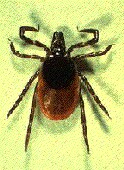- Skip Storing This Everyday Product in the Fridge Door
- Green Tea + B3 Pairing May Boost Brain Health
- Navigating Your Midlife Crisis: Embracing New Possibilities
- City Raccoons Showing Signs of Domestication
- Mapping the Exposome: Science Broadens Focus to Environmental Disease Triggers
- One Week Less on Social Media Linked to Better Mental Health
- Your Brain Changes in Stages as You Age, Study Finds
- Some Suicide Victims Show No Typical Warning Signs, Study Finds
- ByHeart Formula Faces Lawsuits After Babies Sickened With Botulism
- Switch to Vegan Diet Could Cut Your Greenhouse Gas Emissions in Half
One Tick Bite Can Equal Two Infections


If you’re planning to spend quality time outdoors this summer, new research may give you another reason to guard against ticks.
In a New York state study, about one in 10 deer ticks were found to be harboring at least two harmful germs, and the tiny bloodsuckers could pass both infections to a human host through a single bite.
“A third of ticks around here are infected with the Lyme bacteria, and about a third of those are infected with something else, too,” said Felicia Keesing, a biology professor at Bard College in Annandale-on-Hudson, N.Y. That means that about 10 percent of all ticks in her area carry not one but two potentially dangerous diseases.
“If you have been exposed to Lyme disease, there’s a one in three chance that you’ve been exposed to something else at the same time. Those are pretty high odds,” Keesing said.
She has been collecting and testing thousands of deer ticks in Dutchess County in upstate New York, an area that has a lot of tick-borne disease.
Keesing was curious to know how many ticks have the potential to pass multiple infections at the same time. She found that ticks in that area are almost twice as likely as expected to carry two distinct germs — the bacteria that causes Lyme disease and a tiny parasite that infects red blood cells, causing a less common illness called babesiosis.
Her study results were published recently in the journal PLoS One.
On its own, babesiosis usually causes few problems for healthy people, according to the U.S. Centers for Disease Control and Prevention. But it can be life threatening to the elderly, or those who have compromised immune function.
When babesiosis and Lyme disease strike together, however, experts say it tends to compound the symptoms of both infections.
“People who have both infections have more symptoms acutely than people who have Lyme disease alone,” explained Dr. Peter Krause, a senior research scientist at the Yale School of Public Health in New Haven, Conn. “They can experience headache, fever, chills, sweats, fatigue, muscle aches and pains — a lot of symptoms,” he said.
Krause has spent his career studying babesiosis, but he wasn’t involved in the current research.
It’s not known exactly how often people get two infections from a single tick bite because doctors don’t usually know to test for more than one problem. However, Krause conducted a study in 1996 in New England where he tested people with and without symptoms of tick-borne illness to try to capture the true rate of co-infection there.
“We found 240 had Lyme disease, [and] about 26 people had Lyme and babesiosis, so about 11 percent,” he said. That’s a rate that closely mirrors the rates of co-infection Keesing found in upstate N.Y. ticks.
Both Krause and Keesing say that doctors that practice in areas where tick-borne illnesses are common need to be more aware of the problem of co-infection — especially if patients who come in with the symptoms of Lyme disease don’t respond to treatment.
“If people aren’t feeling better within a few days on antibiotics, then the doc has to think, ‘OK, I’m giving the antibiotic that’s probably getting rid of the Lyme disease, then there’s probably something else going on here.’ And there are five other agents that can be transmitted by this tick, besides Lyme disease,” said Krause.
Common-sense measures can help prevent tick-borne infections in the first place.
Krause suggests avoiding places where the bugs like to live, such as wooded and grassy areas. He says avoidance is especially important for people who have weakened immune function.
“If you’re in a wooded area, do tick checks. Wear long pants, a long-sleeved shirt, wear tick repellant,” he said.
And lastly, if you do happen to spot a tick clinging to your skin, don’t freak out.
“Most people who are bitten by ticks aren’t going to develop Lyme disease or any of these other infections,” he said. “We know that only about 3 percent of people bitten by deer ticks get Lyme disease.”
Just be sure to carefully remove the tick as soon as you find it, to help minimize any risk of infection, Krause said.
“If the tick is pulled off before 36 hours of attachment, you’re not going to get it,” he said.
More information
For step-by-step tick removal instructions, visit the U.S. Centers for Disease Control and Prevention.
Source: HealthDay
Copyright © 2025 HealthDay. All rights reserved.










